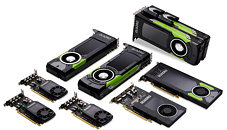- Joined
- Oct 9, 2007
- Messages
- 47,301 (7.52/day)
- Location
- Hyderabad, India
| System Name | RBMK-1000 |
|---|---|
| Processor | AMD Ryzen 7 5700G |
| Motherboard | ASUS ROG Strix B450-E Gaming |
| Cooling | DeepCool Gammax L240 V2 |
| Memory | 2x 8GB G.Skill Sniper X |
| Video Card(s) | Palit GeForce RTX 2080 SUPER GameRock |
| Storage | Western Digital Black NVMe 512GB |
| Display(s) | BenQ 1440p 60 Hz 27-inch |
| Case | Corsair Carbide 100R |
| Audio Device(s) | ASUS SupremeFX S1220A |
| Power Supply | Cooler Master MWE Gold 650W |
| Mouse | ASUS ROG Strix Impact |
| Keyboard | Gamdias Hermes E2 |
| Software | Windows 11 Pro |
NVIDIA today introduced a range of Quadro products, all based on its Pascal architecture, that transform desktop workstations into supercomputers with breakthrough capabilities for professional workflows across many industries. Workflows in design, engineering and other areas are evolving rapidly to meet the exponential growth in data size and complexity that comes with photorealism, virtual reality and deep learning technologies. To tap into these opportunities, the new NVIDIA Quadro Pascal-based lineup provides an enterprise-grade visual computing platform that streamlines design and simulation workflows with up to twice the performance of the previous generation, and ultra-fast memory.
"Professional workflows are now infused with artificial intelligence, virtual reality and photorealism, creating new challenges for our most demanding users," said Bob Pette, vice president of Professional Visualization at NVIDIA. "Our new Quadro lineup provides the graphics and compute performance required to address these challenges. And, by unifying compute and design, the Quadro GP100 transforms the average desktop workstation with the power of a supercomputer."

Benefits of Quadro Pascal Visual Computing Platform The new generation of Quadro Pascal-based GPUs -- the GP100, P4000, P2000, P1000, P600 and P400 -- enables millions of engineers, designers, researchers and artists to: -
View at TechPowerUp Main Site
"Professional workflows are now infused with artificial intelligence, virtual reality and photorealism, creating new challenges for our most demanding users," said Bob Pette, vice president of Professional Visualization at NVIDIA. "Our new Quadro lineup provides the graphics and compute performance required to address these challenges. And, by unifying compute and design, the Quadro GP100 transforms the average desktop workstation with the power of a supercomputer."

Benefits of Quadro Pascal Visual Computing Platform The new generation of Quadro Pascal-based GPUs -- the GP100, P4000, P2000, P1000, P600 and P400 -- enables millions of engineers, designers, researchers and artists to: -
- Unify simulation, HPC, rendering and design - The GP100 combines unprecedented double precision performance(2) with 16GB of high-bandwidth memory (HBM2) so users can conduct simulations during the design process and gather realistic multiphysics simulations faster than ever before. Customers can combine two GP100 GPUs with NVLink technology and scale to 32GB of HBM2 to create a massive visual computing solution on a single workstation.
- Explore deep learning - The GP100 provides more than 20 TFLOPS of 16-bit floating point precision computing(3) -- making it an ideal development platform to enable deep learning in Windows and Linux environments.
- Incorporate VR into design and simulation workflows - The "VR Ready" Quadro GP100 and P4000 have the power to create detailed, lifelike, immersive environments. Larger, more complex designs can be experienced at scale.
- Reap the benefits of photorealistic design - Pascal-based Quadro GPUs can render photorealistic images more than 18 times faster than a CPU.
- Create expansive visual workspaces - Visualize data in high resolution and HDR color on up to four 5K displays.
- Build massive digital signage configurations cost effectively - Up to 32 4K displays can be configured through a single chassis by combining up to eight P4000 GPUs and two Quadro Sync II cards.
View at TechPowerUp Main Site






